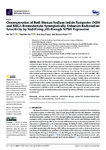Overexpression of Both Human Sodium Iodide Symporter (NIS) and BRG1-Bromodomain Synergistically Enhances Radioiodine Sensitivity by Stabilizing p53 through NPM1 Expression
| dc.contributor.author | Na, Juri | |
| dc.contributor.author | Lee, C-H | |
| dc.contributor.author | Chung, J-K | |
| dc.contributor.author | Youn, H | |
| dc.date.accessioned | 2023-02-20T11:11:53Z | |
| dc.date.issued | 2023-02-01 | |
| dc.identifier.issn | 1422-0067 | |
| dc.identifier.issn | 1422-0067 | |
| dc.identifier.other | ARTN 2761 | |
| dc.identifier.uri | http://hdl.handle.net/10026.1/20441 | |
| dc.description.abstract |
<jats:p>Improved therapeutic strategies are required to minimize side effects associated with radioiodine gene therapy to avoid unnecessary damage to normal cells and radiation-induced secondary malignancies. We previously reported that codon-optimized sodium iodide symporter (oNIS) enhances absorption of I-131 and that the brahma-associated gene 1 bromodomain (BRG1-BRD) causes inefficient DNA damage repair after high-energy X-ray therapy. To increase the therapeutic effect without applying excessive radiation, we considered the combination of oNIS and BRG1-BRD as gene therapy for the most effective radioiodine treatment. The antitumor effect of I-131 with oNIS or oNIS+BRD expression was examined by tumor xenograft models along with functional assays at the cellular level. The synergistic effect of both BRG1-BRD and oNIS gene overexpression resulted in more DNA double-strand breaks and led to reduced cell proliferation/survival rates after I-131 treatment, which was mediated by the p53/p21 pathway. We found increased p53, p21, and nucleophosmin 1 (NPM1) in oNIS- and BRD-expressing cells following I-131 treatment, even though the remaining levels of citrulline and protein arginine deiminase 4 (PAD4) were unchanged at the protein level.</jats:p> | |
| dc.format.extent | 2761-2761 | |
| dc.format.medium | Electronic | |
| dc.language | en | |
| dc.language.iso | eng | |
| dc.publisher | MDPI AG | |
| dc.subject | sodium iodide symporter | |
| dc.subject | radioiodine therapy | |
| dc.subject | iodine-131 | |
| dc.subject | brahma-related gene 1 bromodomain | |
| dc.subject | radiosensitization | |
| dc.subject | thyroid cancer | |
| dc.title | Overexpression of Both Human Sodium Iodide Symporter (NIS) and BRG1-Bromodomain Synergistically Enhances Radioiodine Sensitivity by Stabilizing p53 through NPM1 Expression | |
| dc.type | journal-article | |
| dc.type | Journal Article | |
| plymouth.author-url | https://www.webofscience.com/api/gateway?GWVersion=2&SrcApp=PARTNER_APP&SrcAuth=LinksAMR&KeyUT=WOS:000929718800001&DestLinkType=FullRecord&DestApp=ALL_WOS&UsrCustomerID=11bb513d99f797142bcfeffcc58ea008 | |
| plymouth.issue | 3 | |
| plymouth.volume | 24 | |
| plymouth.publication-status | Published online | |
| plymouth.journal | International Journal of Molecular Sciences | |
| dc.identifier.doi | 10.3390/ijms24032761 | |
| plymouth.organisational-group | /Plymouth | |
| plymouth.organisational-group | /Plymouth/Faculty of Health | |
| plymouth.organisational-group | /Plymouth/Faculty of Health/Peninsula Medical School | |
| plymouth.organisational-group | /Plymouth/REF 2021 Researchers by UoA | |
| plymouth.organisational-group | /Plymouth/REF 2021 Researchers by UoA/UoA01 Clinical Medicine | |
| plymouth.organisational-group | /Plymouth/Users by role | |
| plymouth.organisational-group | /Plymouth/Users by role/Academics | |
| dc.publisher.place | Switzerland | |
| dcterms.dateAccepted | 2023-01-27 | |
| dc.rights.embargodate | 2023-2-21 | |
| dc.identifier.eissn | 1422-0067 | |
| dc.rights.embargoperiod | Not known | |
| rioxxterms.versionofrecord | 10.3390/ijms24032761 | |
| rioxxterms.licenseref.uri | http://www.rioxx.net/licenses/all-rights-reserved | |
| rioxxterms.licenseref.startdate | 2023-02-01 | |
| rioxxterms.type | Journal Article/Review |


